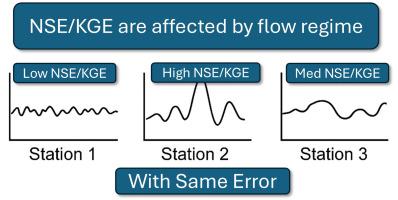朋友不让朋友使用纳什-萨特克利夫效率(NSE)或KGE来评估水文模型的准确性:这是一篇关于更好实践的数据和建议的评论
IF 4.6
2区 环境科学与生态学
Q1 COMPUTER SCIENCE, INTERDISCIPLINARY APPLICATIONS
引用次数: 0
摘要
我评估了纳什-苏特克利夫效率(NSE)和克林-古普塔效率(KGE)在水文模型精度评估中的应用。使用具有相同误差分布的合成数据,(σ = 2), NSE和KGE值变化很大,从- 190到0.999,这是由于流动特性,而不是模型精度。将相同的噪声(σ = 10)应用于6595个美国仪表,具有相同RMSE(~ 10)的模型得到的NSE值从- 325,272到1.0,对应于流量变异性而不是模型拟合。如果噪声占平均流量的25%,则NSE和KGE的空间模式仍然反映流量特征,而不是准确性,并歪曲了准确性。NSE和KGE是技能分数,用于站点内模型校准,而不是跨站点精度比较。诸如RMSE、标准化RMSE或百分比偏差之类的度量提供了更多可解释的、可转移的准确性评估。我主张放弃NSE和KGE来比较模型的性能,并敦促水文学家采用符合目的的指标。我把这项研究作为一份立场文件,而不是一份研究报告,NSE和kge的局限性——尤其是它们对流量变异性的依赖和不适合跨站点比较——是众所周知的,并且在文献中得到了广泛的讨论。然而,我的经验和对文献的回顾表明了对这些指标的过度依赖和滥用。本文章由计算机程序翻译,如有差异,请以英文原文为准。

Friends don't let friends use Nash-Sutcliffe Efficiency (NSE) or KGE for hydrologic model accuracy evaluation: A rant with data and suggestions for better practice
I evaluate the use of Nash-Sutcliffe Efficiency (NSE) and Kling-Gupta Efficiency (KGE) for hydrologic model accuracy assessment. Using synthetic data with identical error distributions, (σ = 2), NSE and KGE values vary widely—from −190 to 0.999—due to flow characteristics, not model accuracy. Applying identical noise, (σ = 10), to 6595 U.S. gages, models with identical RMSE (∼10) results in NSE values from −325,272 to 1.0 which corresponds with flow variability rather than model fit. If noise is scaled to 25 % of mean flow, spatial patterns in NSE and KGE persist that reflect flow characteristics rather than accuracy and misrepresent accuracy. NSE and KGE are skill scores and useful for within-site model calibration, not cross-site accuracy comparisons. Metrics such as RMSE, normalized RMSE, or percent bias offer more interpretable, transferable accuracy evaluations. I advocate abandoning NSE and KGE for comparisons of model performance and urge hydrologists to adopt fit-for-purpose metrics. I present this study as a position paper, rather than a research paper, the limitations of NSE and KGE—particularly their dependence on flow variability and unsuitability for cross-site comparisons—are well known and have been addressed extensively in the literature. However, my experience and review of the literature indicate an over-reliance and misuse of these metrics.
求助全文
通过发布文献求助,成功后即可免费获取论文全文。
去求助
来源期刊

Environmental Modelling & Software
工程技术-工程:环境
CiteScore
9.30
自引率
8.20%
发文量
241
审稿时长
60 days
期刊介绍:
Environmental Modelling & Software publishes contributions, in the form of research articles, reviews and short communications, on recent advances in environmental modelling and/or software. The aim is to improve our capacity to represent, understand, predict or manage the behaviour of environmental systems at all practical scales, and to communicate those improvements to a wide scientific and professional audience.
 求助内容:
求助内容: 应助结果提醒方式:
应助结果提醒方式:


